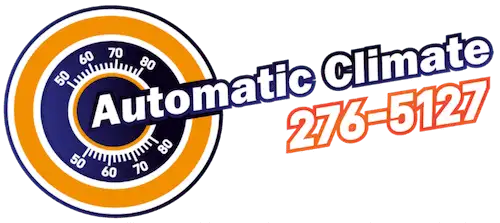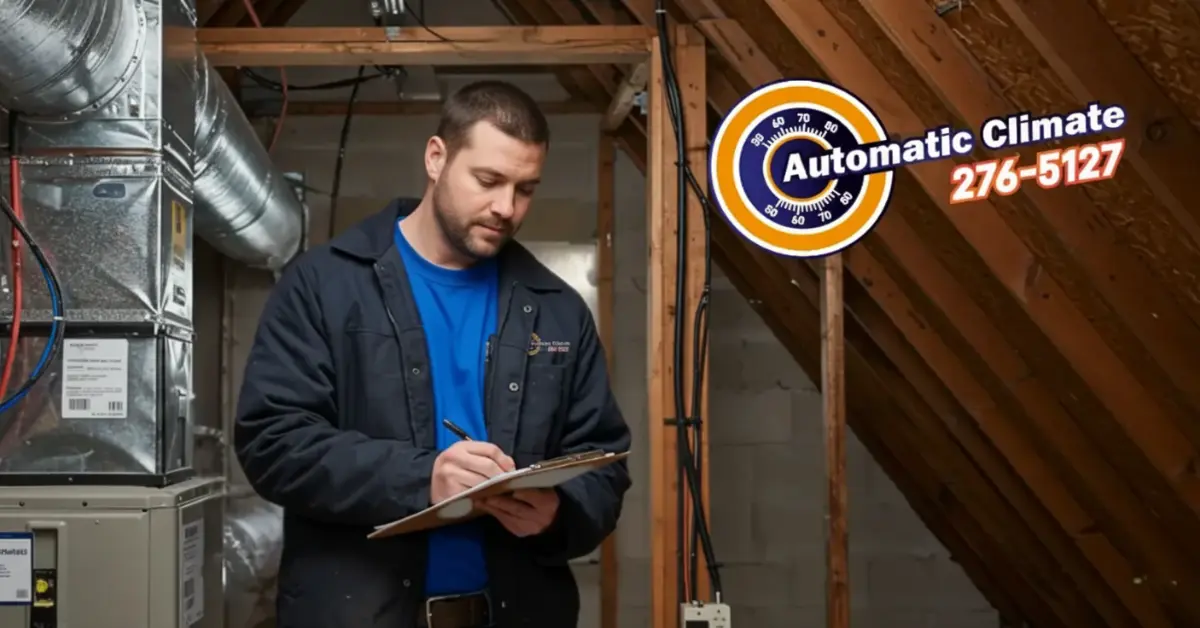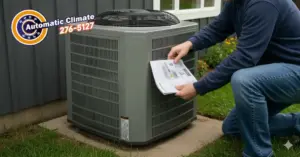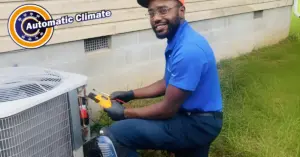Affordable Furnace Maintenance: Is It Worth It and What Should It Cost?
Written by Cole Summers at Automatic Climate in Richmond, Virginia.
The first chilly breeze of fall in Richmond is a gentle reminder, but that first truly cold night? That’s a different story. It’s the annual signal to ask the big question: “Is my furnace ready?” This question is almost always followed by another, more complicated one: “Do I really need to schedule furnace maintenance?” It’s a task on the to-do list that feels… optional. It’s an expense that seems easy to cut, especially when you’re trying to be budget-conscious. But here’s the thing: “affordable” doesn’t just mean cheap. “Affordable” means it provides more value than it costs. And when it comes to furnace maintenance, the value is measured in safety, efficiency, and peace of mind. Skipping it might save you a little bit now, but it could cost you alot more down the road.
Let’s be honest, most homeowners don’t think about their furnace until it stops working. It’s a classic case of “out of sight, out of mind.” That humming box in the basement or closet is just expected to work. But just like your car, your furnace is a complex machine with moving parts, electrical components, and fuel sources. You wouldn’t drive your car for 30,000 miles without an oil change, would you? Doing so would be asking for a breakdown. Your furnace is the same. It runs for hundreds, even thousands, of hours each winter. Professional furnace maintenance is its annual check-up, its “oil change,” and its safety inspection all rolled into one. It’s the single most important thing you can do to ensure your heating system runs reliably and efficiently all winter long.
The “Is It Worth It?” Debate: Safety, Savings, and Lifespan
So, let’s tackle the big question head-on. Many homeowners ask, is furnace maintenance worth it at all? When the system *seems* to be working fine, it can feel like you’re paying for nothing. The truth is, you’re paying for prevention, and prevention is where the real value lies. Let’s break down the three main pillars of value you get from annual furnace maintenance.
1. The Non-Negotiable: Your Family’s Safety
This is, without a doubt, the most important reason to schedule furnace maintenance. Your furnace is a fuel-burning appliance. Whether it uses natural gas or oil, it creates combustion to generate heat. A system that isn’t properly maintained can become a serious hazard. During a tune-up, a profesionally trained technician performs critical safety checks. They inspect for gas leaks at the connections and valves. They test safety controls to ensure they’re functioning. Most importantly, they inspect the heat exchanger. A heat exchanger is the metal wall that separates the fire (combustion gases) from your breathing air (the air blown through your home). Over time, this component can develop cracks. If it cracks, it can leak carbon monoxide (CO)—a colorless, odorless, and deadly gas—directly into your home’s airstream. A furnace maintenance technician is trained to spot these tiny, hairline cracks before they become a catastrophic problem. This single check is worth the entire cost of the service.
2. The Financial Win: Efficiency and Lower Bills
A dirty, neglected furnace has to work much harder to produce the same amount of heat. Think about it: if the burners are dirty, they don’t combust fuel efficiently. If the blower wheel is caked in dust, it can’t move as much air. If the filter is clogged, the entire system is “choking” and straining to pull air through. All this strain adds up, causing your furnace to run for longer cycles and use more energy. This directly translates to higher utility bills every single month. Proper furnace maintenance addresses all of this. By cleaning the burners, lubricating moving parts, and ensuring clear airflow, a technician restores your system to its peak operating efficiency. In many cases, the energy savings from a single furnace maintenance appointment can offset a significant portion of the service cost over the course of the winter. You’re not just spending money; you’re investing in efficiency that pays you back.
3. The Long-Term Play: Extending Your Furnace’s Lifespan
A new furnace is one of the most expensive appliances you’ll ever buy for your home. It’s a major investment. Doesn’t it make sense to protect it? Annual furnace maintenance is the key to extending its service life. All that strain we just talked about? It doesn’t just cost you money in utilities; it causes premature wear and tear on critical components. Motors that run hotter burn out faster. Parts that aren’t lubricated create friction and fail. Systems that are constantly straining are more likely to have a major component failure. Regular furnace maintenance is preventative care. It catches small issues—like a fraying belt, a sticky valve, or a struggling capacitor—and fixes them *before* they cascade into a system-wide breakdown. This proactive approach can add years to the life of your furnace, pushing that massive replacement cost much further into the future.
Ultimately, understanding the true furnace maintenance cost isn’t just about the line item on the invoice. It’s about comparing that predictable, affordable cost to the unpredictable and massive costs of an unexpected repair, a sky-high utility bill, or a premature furnace replacement.
The Cost of Prevention vs. The Price of Neglect
Annual Furnace Maintenance (Proactive)
This is a planned, affordable service. Its a small investment that provides immense value by:
- Ensuring Safety: Catches risks like CO leaks or fire hazards.
- Boosting Efficiency: Lowers your monthly utility bills.
- Preventing Major Repairs: Fixes small issues before they become big ones.
- Extending Lifespan: Protects your large investment.
- Maintaining Warranty: Keeps your manufacturer’s warranty valid.
Cost: A low, predictable annual fee.
Unexpected System Failures (Reactive)
These are unplanned, stressful, and expensive events. These costs are often much higher and include:
- Failed Ignitor/Flame Sensor: A common failure that leaves you in the cold.
- Burned-Out Blower Motor: A very expensive repair, often caused by strain.
- Cracked Heat Exchanger: A critical safety hazard that often means replacing the entire furnace.
- Failed Control Board: The “brain” of the furnace, and a costly part to replace.
Cost: A high, unpredictable, and stressful bill… at the worst possible time.
Sources for cost and repair data: Today’s Homeowner, This Old House
What Is Actually Included in a Professional Furnace Maintenance Tune-Up?
Not all furnace maintenance visits are created equal. Some companies offer a “quick check” that’s little more than a filter change. A true, comprehensive furnace tune-up is a detailed process performed by a professional. At Automatic Climate, we’ve been serving the Richmond community since 1983, and we believe in thorough, valuable service. Our trained technicians undergo continuous, rigorous training to stay on top of all furnace makes and models. They follow a detailed checklist to ensure every part of your system is inspected, cleaned, and tuned for peak performance.
When one of our techs visits your home for furnace maintenance, they are performing a meticulous service designed to cover safety, efficiency, and longevity. Here’s a detailed look at what our process involves for the two most common types of systems.
Key Components of Our Gas Furnace Tune-Up
For gas furnaces, which are common in our area, the furnace maintenance process is all about the “Three C’s”: Combustion, Controls, and Circulation.
- Safety Inspection: Our comprehensive furnace maintenance always begins with safety. Our technician will conduct a thorough inspection to identify any potential safety hazards. This includes visual checks and electronic testing for gas leaks, evaluating the risk of carbon monoxide, and inspecting all electrical components for wear, fraying, or unsafe connections. This is the foundation of a safe and reliable system.
- Component Inspection and Cleaning: This is the core of the furnace maintenance tune-up. Our technicians meticulously clean critical components like the burners and flame sensor. A dirty flame sensor can cause the furnace to shut off randomly, while dirty burners lead to inefficient and incomplete combustion (which costs you money and can create CO). We also inspect the heat exchanger for any signs of stress or cracks, the blower assembly for dirt buildup, and the inducer motor to ensure it’s venting exhaust gases properly.
- System Performance Testing: Once everything is inspected and clean, we need to see it run. We test the furnace’s ignition system to ensure it’s reliable and safe. We check the thermostat’s calibration to make sure it’s “talking” to the furnace correctly. We also test the airflow across the system to identify any blockages or issues with the blower, ensuring that the warm air is actually getting to your rooms efficiently.
- Lubrication and Adjustments: Moving parts, like the blower motor, create friction. As part of our furnace maintenance, we lubricate these parts as specified by the manufacturer. This reduces wear and tear, quiets the system, and can prevent the motor from seizing, which is a very expensive repair. We also make any necessary adjustments to settings to optimize fuel efficiency and heating output, tuning the system for your specific home.
- Filter Check and Replacement: A clogged air filter is the number one cause of furnace problems. It restricts airflow, making the system overheat and components fail. While we recommend homeowners check their filters monthly, our technician will inspect it during the furnace maintenance visit and, if necessary, replace it with a new one provided by you, the client. This simple step is vital for airflow and indoor air quality.
- Energy Efficiency Optimization: By fine-tuning the entire system—cleaning the burners, ensuring proper airflow, and checking the combustion mix—we help reduce your furnace’s energy consumption. This not only lowers your utility bills but also reduces your home’s environmental impact. A well-maintained furnace is a green furnace.
Key Components of Our Boiler Tune-Up
Boilers are different from furnaces, using hot water or steam to heat your home, but they still require annual furnace maintenance (or in this case, boiler maintenance) to run safely and efficiently.
- Safety Inspection: Just like a furnace, boiler safety is paramount. We conduct a thorough inspection to identify potential safety hazards. This includes checking for gas leaks, carbon monoxide risks (a serious concern with any combustion appliance), and inspecting all faulty electrical or pressure components. A boiler is a pressure vessel, so checking the pressure relief valve is a critical step in our furnace maintenance for boilers.
- Component Inspection and Cleaning: Our technicians clean critical components such as the burners and flame sensors to ensure efficient combustion. We inspect the heat exchanger for scale or corrosion, check the circulator pump to ensure it’s moving water, test the inducer motor, and verify the expansion tank and backflow preventer are operating correctly to maintain proper system pressure and prevent contamination.
- System Performance Testing: We test the boiler’s ignition system, check the thermostat’s accuracy, and, very importantly, test the water pressure. Incorrect pressure can damage the system or lead to inefficient heating. This part of the furnace maintenance visit confirms the entire system is working in harmony.
- Air Removal from Lines: If you have a hydronic (hot water) system, air can get trapped in the lines and radiators, causing those annoying “gurgling” sounds and preventing the radiators from heating up fully. We bleed the radiators to ensure no air is present in the system, which promotes efficient heat distribution and prevents strain on the circulator pump.
- System Check and Maintenance: We inspect and, if necessary, clean or replace strainers that protect components from debris in the water. We also check the water chemistry to maintain proper system operation and prevent internal corrosion.
A Note on Duct Cleaning
While not always part of a standard furnace maintenance tune-up, many homeowners ask us about air duct cleaning. If your furnace maintenance is like an oil change, duct cleaning is like a deep detailing. It’s important to know *how* it’s done. At Automatic Climate, we are *not* a NADCA certified company. We use a Rotobrush machine. This process involves a patented whip system with a flexible hose and a rotating brush head that agitates and dislodges dust, pollen, and debris from the duct walls. As the brush spins, a powerful vacuum with HEPA filters simultaneously extracts these contaminants, preventing them from spreading into your home. We do *not* use a high-pressure machine. We also only use a camera to view the ducts if the customer specifically requests it. It’s a great add-on to your furnace maintenance plan if you’re concerned about indoor air quality.
Your Furnace Maintenance Role: DIY vs. Pro
Your Monthly DIY Checklist
You play a key role in your furnace’s health. These simple tasks are part of your own furnace maintenance routine:
- Check/Change the Air Filter: This is the #1 thing you can do. A clogged filter is an efficiency killer. Check it monthly!
- Keep the Area Clear: Ensure the area around your furnace is clear of boxes, laundry, or flammable items. It needs to breathe.
- Check Your Thermostat: Learn its settings. If it’s battery-powered, change the batteries annually.
- Look and Listen: Keep an ear out for strange noises (rattling, banging, squealing) and an eye out for any puddles or soot.
Our Annual Pro Tune-Up
This is the technical service that requires training and tools. Leave this part of the furnace maintenance to us:
- Clean Burners & Flame Sensor: Ensures efficient, safe combustion.
- Inspect Heat Exchanger: The critical safety check for cracks and CO leaks.
- Test Electrical Components: Check capacitors, wiring, and safety controls.
- Lubricate Motors: Prevents wear and tear on moving parts.
- Analyze Combustion/Exhaust: We ensure your furnace is burning fuel safely and venting properly.
Sources for DIY vs. Pro tasks: Bob Vila, Family Handyman
The High Price of Skipping Furnace Maintenance
We’ve covered the “why,” but what about the “what if I don’t?” The consequences of neglecting furnace maintenance range from inconvenient and expensive to downright dangerous. It’s not just about a potential breakdown; it’s about a cascade of problems that all stem from that one decision to skip your annual service. When you skip a furnace maintenance appointment, you’re not really saving money; you’re just deferring the cost, and it almost always comes back higher.
As Benjamin Franklin famously said, “An ounce of prevention is worth a pound of cure.” This has never been more true than with furnace maintenance. That “ounce of prevention” is your annual tune-up. The “pound of cure” is an unplanned breakdown on a freezing January night, a failed blower motor, or a cracked heat exchanger.
1. Kiss Your Warranty Goodbye
This is a financial risk few homeowners are aware of. Most furnace manufacturers’ warranties are not unconditional. If you read the fine print, they often state that the warranty on major parts (which can be 5, 10, or even 20 years for a heat exchanger) is only valid *if* the system has been professionally maintained annually. If your 7-year-old furnace has a major component failure and you can’t provide records of annual furnace maintenance, the manufacturer may have the right to deny your warranty claim. You would then be on the hook for a repair that could cost thousands. Your annual furnace maintenance service from a company like Automatic Climate provides a digital or paper trail that proves you’ve held up your end of the bargain, keeping your investment protected.
2. The Breakdown You *Know* Is Coming
Furnaces rarely just “stop.” They usually give warning signs that a non-expert would never notice. A capacitor that’s slightly out of spec. A motor that’s pulling too many amps. A flame sensor that’s getting dirty. A furnace maintenance technician catches these things. They replace that weakening capacitor, clean that sensor, and flag that struggling motor. If you skip the furnace maintenance, those small problems are left to fester. That weak capacitor eventually fails, leaving you with no heat. That dirty sensor finally fails to detect a flame and shuts your system down. These breakdowns don’t happen on a warm October afternoon; they happen in the dead of winter when your system is under the most strain. And that’s when you’ll be making a call for a heating repair, which is always more expensive than maintenance.
Our goal at Automatic Climate is to help you *avoid* those critical heating failures altogether. A well-maintained system is a reliable system.
3. The Silent Hazard: Poor Air Quality
Your furnace doesn’t just move heat; it moves *air*. It is the “lungs” of your home, circulating every bit of air you breathe through its internal components and your ductwork. If the system is dirty, if the filter is clogged, if the blower wheel is caked in dust and debris… you’re breathing that. A neglected furnace maintenance routine can contribute to poor indoor air quality, which can aggravate allergies, asthma, and other respiratory issues. We all want our home to be a comfortable sanctuary. Laura Ingalls Wilder said, “Home is the nicest word there is.” But a home that’s circulating dust, dander, and allergens isn’t as nice as it could be. A clean system, starting with your annual furnace maintenance, is the first step to cleaner, healthier air for your family.
Don’t Wait for the Cold! Schedule Your Furnace Maintenance Today.
Protect your home, your family, and your budget. The professionally trained technicians at Automatic Climate have been trusted by Richmond homeowners since 1983. We provide thorough, reliable, and affordable furnace maintenance to ensure your system is safe and ready for winter.
Or call us at (804) 803-1983
Case Study: The Richmond Homeowner Who Was Glad They Scheduled
The ‘S’ family in Richmond had been putting off their furnace maintenance for a few years. Their system was about 12 years old and, from their perspective, was working “just fine.” They received a reminder from us, and on a whim, decided to schedule a tune-up, thinking it would be a simple “check-the-box” service.
Our professionally trained technician, Mike, arrived and began his standard furnace maintenance procedure. Everything seemed normal… until he got to the heat exchanger inspection. Using a specialized camera, Mike found something the homeowners never could have seen: a small, hairline crack in the heat exchanger. It wasn’t large, but it was there. And it was a clear and present danger.
He immediately shut the system down, showed the family the camera feed, and explained the serious risk of carbon monoxide poisoning. A serious CO leak was not just possible; it was imminent. Because this was caught during a routine furnace maintenance visit in the fall, the family wasn’t in a panic. They had time to review their options and schedule a planned furnace replacement, rather than facing a terrifying and dangerous situation in the middle of winter. The cost of that furnace maintenance call saved them from a hazard that could have cost them everything.
This story is a common one. According to the Bureau of Labor Statistics, identifying and repairing these exact problems is a key and vital role of HVAC technicians.
Beyond the Basics: Furnace Maintenance and Your Whole-Home Health
Your annual furnace maintenance is the starting point, not the end point, for your home’s comfort and health. The furnace is part of a larger, interconnected system, and understanding how it all works together can help you see the even greater value in keeping it maintained. When you get a furnace tune-up, you’re positively impacting several other areas of your home.
First, let’s talk about Indoor Air Quality (IAQ). As we’ve mentioned, your furnace and ductwork are responsible for circulating all the air in your home. A clean filter, a clean blower, and clean burners—all part of your furnace maintenance—are step one. But what about the ducts themselves? Over years, dust, pet dander, pollen, and other debris can build up in the ductwork. When your furnace kicks on, it can dislodge and blow these particles into your rooms. This is why a service like our Rotobrush duct cleaning can be such a powerful partner to your annual furnace maintenance. By cleaning both the “lungs” (the furnace) and the “airways” (the ducts), you can significantly improve your home’s IAQ, which is a blessing for anyone with allergies or respiratory sensitivities.
Maintenance vs. Repair: The Critical Difference
It’s also crucial to understand the difference between furnace maintenance and heating repair. Think of it this way: furnace maintenance is proactive. It’s the check-up. It’s what you schedule in the fall to prevent problems. Heating repair is reactive. It’s the “ER visit.” It’s what you’re forced to do when something has already broken.
Our furnace maintenance service is designed to be affordable and predictable. A repair, on the other hand, is almost always an unexpected and unwelcome expense. The goal of our heating maintenance agreements is to keep you in the “maintenance” camp and far away from the “repair” camp. By investing a small, manageable amount each year in furnace maintenance, you are actively working to avoid the much larger, stressful costs of repairs. Your whole system, which a furnace buying guide will tell you, is a complex machine. Letting it run without checks is a gamble, and the odds are not in your favor.
So when you think about that line item for “affordable furnace maintenance,” reframe it. It’s not a cost; it’s an investment. It’s an investment in safety, an investment in efficiency, an investment in reliability, and an investment in the longevity of one of your home’s most critical systems. Understanding what maintenance is required is the first step. Taking action and scheduling that call is the second.
Frequently Asked Questions About Furnace Maintenance
External Resources & Further Reading
For more information on furnace maintenance, costs, and best practices, we recommend these national resources:
- Today’s Homeowner: HVAC Maintenance Cost
- Fox Business: Does Your Furnace Really Need a Yearly Inspection?
- This Old House: What Does HVAC Maintenance Cost?
- Bob Vila: Furnace Troubleshooting Tips from the Pros
- Family Handyman: What Is a Furnace Tune-Up?
- CNET: Furnace Buying Guide
- Bureau of Labor Statistics: HVAC Technicians Handbook
- Carrier: Furnace Tune-Up Guide & Checklist
- Enercare: What Type of Maintenance is Required for Your Furnace?
- Major Heating: Fall Furnace Maintenance Checklist
Hashtags
#furnacemaintenance #hvac #hvactech #richmondva #rva #homeheating #heatingmaintenance #furnacetuneup #affordablehvac #safetyfirst #automaticclimate #hvacmaintenance #homeownertips #winteriscoming #heatingbills
Legal Disclaimer:
This article was drafted with the assistance of a Large Language Model, specifically Gemini, which was used for initial drafting and article outlining. The content was subsequently reviewed, edited, and fact-checked by a human writer to ensure accuracy, clarity, and adherence to editorial standards. While AI assists in the creation of this content, the human author(s) retain editorial control and full responsibility for the final content, including its accuracy and integrity. Readers should be aware that AI-generated content may present limitations, and the information provided should be considered with this in mind.
The information provided in this article is for general informational purposes only. While we strive to keep the information up-to-date and correct, we make no representations or warranties of any kind, express or implied, about the completeness, accuracy, reliability, suitability, or availability with respect to the 1 article or the information, products, services, or related graphics contained in the article for any purpose. Any reliance you place on such information is therefore strictly at your own risk. 2 HVAC systems involve electrical components, refrigerant, and potentially natural gas; attempting repairs without proper training and safety precautions can result in injury, property damage, or voiding warranties. Always consult with a qualified and licensed HVAC professional, like those at Automatic Climate (https://www.automaticclimate.com/, (804) 803-1983), for diagnosis and repair of HVAC issues.

Cole Summers
Cole Summers is an HVAC technician in VA, bringing a wealth of hands-on experience to his writing. Cole provides valuable insights into the world of home comfort. Automatic Climate, a family-owned business since 1983, is known for its reliable service and commitment to customer satisfaction. Cole combines his technical knowledge with a passion for clear and informative writing, making complex HVAC topics accessible to everyone.







